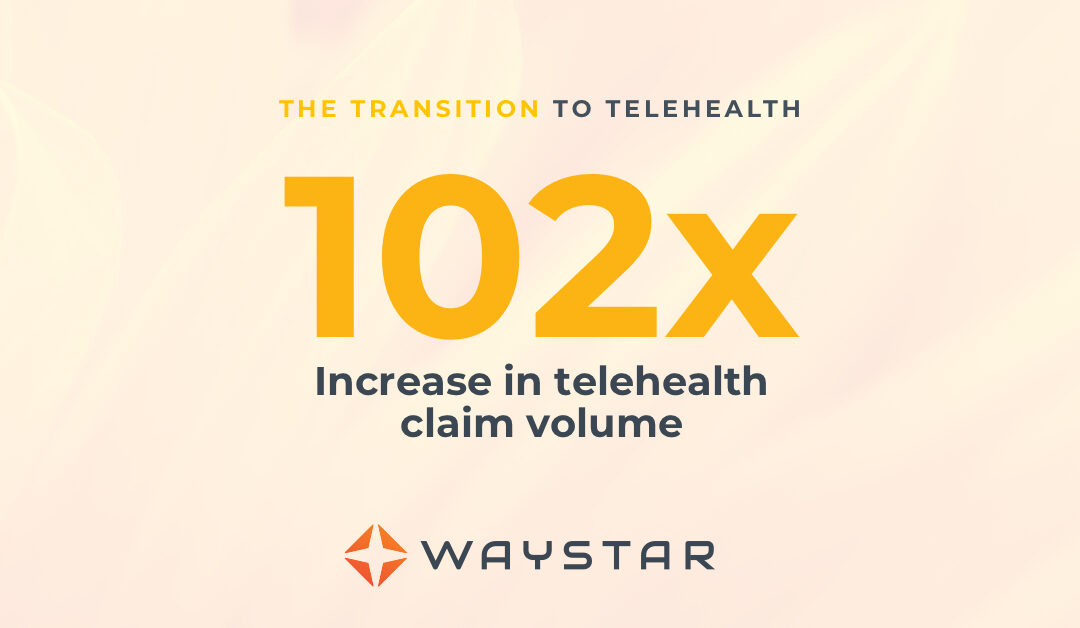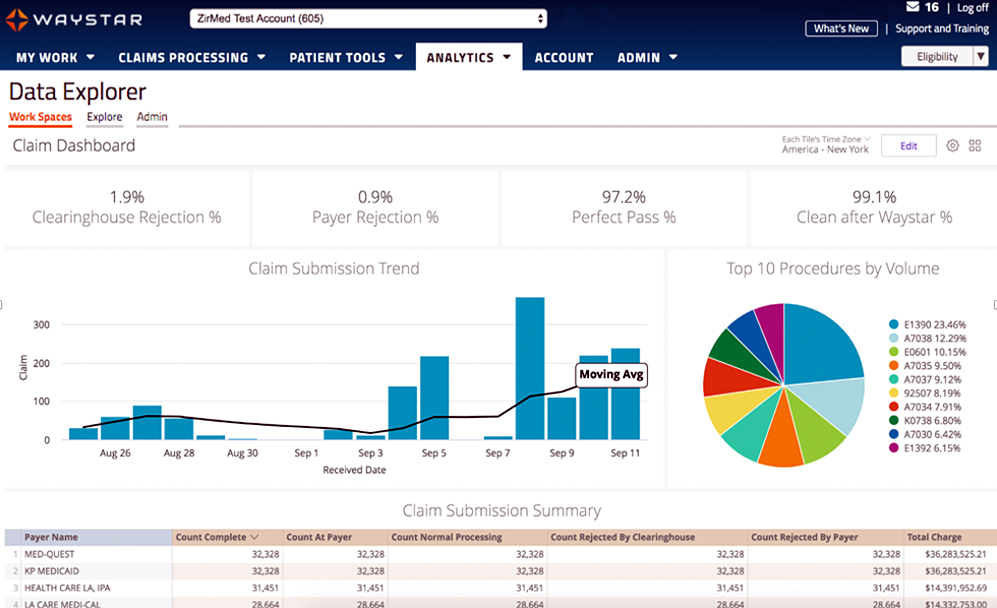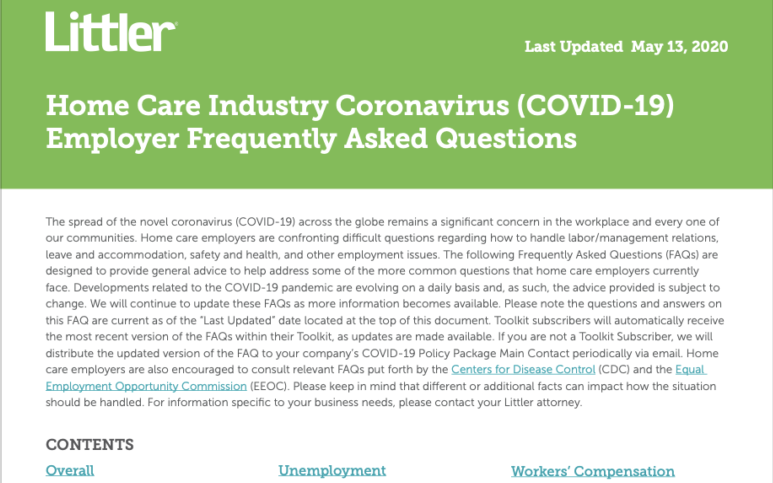
Sep 10, 2020 | Electronic Billing, Medical Billing Software Blog, Partner
In the wake of the COVID-19 pandemic, Telehealth adoption has exploded, and there are six revenue cycle metrics to track.
Many patients are prohibited or reluctant to venture out for on-site care. The combination of relaxed regulations and expanded payment parity for appointments has made virtual meetings easier and more attractive for providers, who are turning to these technologies to stay engaged with patients—and maintain cashflow. Dr. Robert McLean, a former president of the American College of Physicians, recently said, “this crisis has forced us to change how we deliver health care more in 20 days than we had in 20 years.”
A new industry report predicts that the number of Telehealth visits in the US will surpass one billion by the end of the year, and speculates that nearly half of those visits will be related to COVID-19. At Waystar, we have been closely monitoring claim trends and are seeing this growth firsthand. In fact, the volume of Telehealth claims on the Waystar platform has grown by more than 100 times since mid-March. On two particular days in late April, they accounted for more than 15% of our total daily claim volume. Before COVID-19, they would have accounted for less than one percent!
For many providers, this shift will require new revenue cycle strategies to meet growing patient demand without overwhelming clinicians and administrative teams—or already strained operating budgets. It’s important to remember this is still very much an evolving care delivery model with the opportunity for errors on the part of both payers, providers, and administrative staff. For this reason, revenue cycle professionals should diligently monitor claims to ensure proper adjudication, identify learning opportunities, and uncover areas for operational improvement.
Below, we’ve listed six core Telehealth-related metrics you should regularly track to ensure billing accuracy, maximize payer reimbursement, and reduce claim rejections and denials. For more on how to best navigate the evolving telemedicine landscape, check out our resource hub here.
To report on Telehealth-related claims, you’ll first need to identify and isolate claims containing Telehealth procedure codes. See CMS’ Telehealth code list to identify the specific procedure codes and modifiers that apply to your organization.
Payer Analysis:
1. Payer Telehealth claim rejections by volume and/or billed amount
2. Payer Telehealth claim denials by volume and/or billed amount
If your Telehealth claims are being denied or rejected, do you know which specific payers are doing so at the highest rate? Drill down to discover the specific reason codes payers are attaching to rejections and denials so you can better understand payer-specific rules and avoid these oversights in the future. In some cases, you may identify trends that warrant a call to the payer to correct.
Provider Analysis:
3. Telehealth claim volume by the provider
Review this claim volume by individual provider. If you notice providers within your organization generating a much lower volume of Telehealth claims than peers, perhaps they could benefit from additional training on Telehealth technology and use cases.
Ensuring Billing Accuracy:
4. Telehealth claim rejections by biller/team
5. Telehealth claim denials by biller/team
Are certain billing personnel or teams producing higher denial or rejection rates than others? Keep a close eye on these trends and remember most of this is new for everyone. If some team members are seeing more rejections or denials than they should, it could be a great opportunity to hold training and collaborate on strategies for success.
Maximizing Reimbursement:
6. Telehealth claim volume by procedure code
Which Telehealth codes are you using? Each code reimburses at a different rate, so choosing the wrong ones could leave money on the table. Be sure to read up on CMS’ requirements (check out their fact sheet and code list) to ensure you’re choosing the appropriate code(s) on each Telehealth claim.
Waystar Analytics
You have all the data you need to drive informed decision making and improve financial performance—you just need the right analytics tool in your corner. Our new Waystar Analytics solution offers a pre-built Telehealth dashboard that can help you easily interpret, share all the metrics above, and track these revenue cycle metrics. Click here to learn more about Waystar Analytics and how it can deliver the insights you need during this time of transition.

[ By Waystar ]

Sep 10, 2020 | Electronic Billing, Medical Billing Software Blog
So, it looks that there will be a lot new for E/M coding (Evaluation and Management) in 2021, and practices should start to get ready for it.
Well, it seems the only constant in the world of medical billing changes, and 2020 would only compliment that cliché. While the chaos of COVID-19 forced many unexpected changes—how you see your patients and bill for services—a bigger change is in the works for 2021. This change will complement the “Patients Over Paperwork” initiative from CMS and the AMA, which has been developed to eliminate “Note Bloat.” So, since the new year will roll out changes to E/M visits, now is the time to make sure that all parties are prepared for this long overdue and welcome change to medical billing.
Evaluation and management services have been long overdue for an overhaul. The 1995/1997 guidelines were in place well before electronic medical records, and with the growth of EMR’s, the process to document for a specific level required a lot of tedious, unnecessary documentation. (A cursory look at some of the proposed updates for E/M CPT coding and documentation requirements will verify that!)
PROPOSED CHANGES:
• History and Examination: While the elements of history and examination that are pertinent to a specific visit shall be recorded, they will no longer be used to ‘score’ the level billed
• Code Selection: It will be based on MDM or time
• Medical Decision Making: It will still utilize the CMS Table of Risk. However, the wording and explanations are being updated to provide more concise language. For instance, definitions will now be included to clearly identify subjective wording like “self-limited and stable chronic illness.” The clinical example will likely be removed, and the terms are more clearly defined. We will see this same type of clarification in the MDM table. For example, the 2021 guidelines will specify that the amount and/or complexity of data to be reviewed must also include analysis.
• Time-based Code Selection: It will also be easier. The guidelines will give specific amounts of time rather than the generic estimate that we currently see attached to E/M codes. Another major advantage to the codes selected based on time, they will now include non-face-to-face services. There will also be additional add on codes—in 15-minute increments—if the time has been exceeded for the 99205 or 99215.
While changes are daunting, this change will be rewarding from a documentation standpoint. So, if you need help with training your team on these new updates, there are FREE videos available on the AMA website, or you can enlist the help of an independent consultant like RCM Insight.
One way of keeping up with these changes is to use EZClaim’s medical billing software, which is continually updated. For more details, visit their website, ezclaim.com, contact them, or just give them a call at 877.650.0904.
[ Written by Stephanie Cremeans of EZClaim ]

Jun 10, 2020 | Partner, Support and Training
Home care employers are confronting difficult questions regarding how to handle labor and management relations, leave and accommodation, safety and health, and other employment issues.
Littler, a law firm that focuses on labor and employment law, has produced an extensive home care industry FAQ document (41 pages) called “Home Care Industry Coronavirus (COVID-19) Employer Frequently Asked Questions.“ It provides general advice to help address some of the more common questions that home care employers currently face due to the COVID-19 pandemic.
CONTENTS:
• Client/Patient Privacy/HIPAA
• FFCRA
• CARES Act (Including PPP)
• Unemployment
• ADA Considerations
• Leaves of Absence
• Wage & Hour
• WARN Act
• Workers’ Compensation
• Health and Safety
• Labor/Management Relations
• Employee Relations
Litter also has a specific page on their website that provides a useful resource for employers to learn how COVID-19 is affecting various aspects of employment law, and how different jurisdictions are addressing the outbreak. Because the COVID-19 situation is dynamic, with new governmental measures each day, Litter suggests that employers consult with counsel for the latest developments and updated guidance on this topic. Click here to view their resource page.
This information was sent to us by one of EZClaim’s premier partners, AxisCare, who provides a home care system designed with the workflow of a private duty agency in mind. AxisCare provides a scheduling software solution that features a GPS mobile app, automatic invoicing, billing and payroll integrations, custom forms, custom reporting, and more. For more details about their all-in-one home care software solution, view their website.
Since developments related to the COVID-19 pandemic are evolving on a daily basis, EZClaim is continuing to discover resources that will assist its clients in understanding these developments. As always, we are here to support your medical billing needs and hope you are safe and well in this challenging time.
For general information about EZClaim, or details about the features of our medical billing software, visit our website.
Click here to download the PDF

Jun 10, 2020 | Alpha II, Medical Billing Software Blog, Partner, Revenue, Webinar
Concerned about the claims process during COVID-19? Well, Alpha II remains on the forefront of the coding and billing changes during the COVID-19 public health emergency (PHE). They understand this is a confusing time for providers, practices, and hospitals.
Now more than ever, practitioners are relying on the revenue brought in by accurate claim submission. So, if you would like more up-to-date details, join us for our Bring Revenue Integrity to the Claims Process During COVID-19 webinar on June 16th at 1 p.m. ET, and learn how to recover revenue based on the waivers allowed under the PHE. Click here to register for the webinar.
We have also compiled a comprehensive COVID-19 billing and coding FAQ document of questions received during our highly-attended webinar series. Click here to download the resource.
As guidelines for coding and billing of COVID-19 services are revised regularly, Alpha II is implementing these critical changes to regulations and coding guidance—almost immediately.
Alpha II empowers precision across the revenue cycle process so you can experience reduced cost, improved cash flow, and increased revenue. Through its software-as-a-service (SaaS) solutions, Alpha II supports coding, compliance, claims editing, value-based quality reporting, and revenue analysis.
For more details about how Alpha II’s solutions can keep your coding, billing, and editing current, view our website or fill out our contact form to ask us a specific question.
Alpha II is a preferred partner of EZClaim, and their software is integrated into our medical billing software. For detailed product features or general information about EZClaim, visit our website at ezclaim.com/


Jun 10, 2020 | BillFlash, Electronic Billing, Medical Billing Software Blog, Partner
There are five things to consider as you reopen your medical office: Reevaluate your budget; Get your staff’s buy-in; How to actively bring patients back into the office; Continuing to use Telemedicine and other online tools, and be flexible.
As the curve flattens and restrictions around the country loosen up, medical practices are slowly reopening their doors for non-essential services. But reopening doesn’t mean business will resume as usual. Every industry is making changes as we navigate a “new normal.”
Many of those changes center on social distancing guidelines, but there are other matters to consider as well. Here are some details about the strategies to keep in mind as you reopen.
Reevaluate Your Budget
Government restrictions may be lifting, but medical practices are not going to bounce back immediately. Any financial goals you had in place for 2020 likely won’t be met this year.
Some budgetary adjustments will be necessary. Here are just a few ideas:
- Check in with vendors, landlords, and creditors to discuss any accommodations they may have for cash-flow disruptions
- Consider delaying payment of bonuses and other discretionary payments
- Seek aid from government economic relief packages and loans for small businesses and front-line workers. Stay informed on what your options are, as changes are ongoing.
This goes without saying, but make sure you’re up to date on patient billing and payments, too, including telemedicine visits. If you have patients who need extra time to pay their bills, EZClaim customers can set up a payment plan for them using BillFlash PlanPay.
Get Your Staff’s Buy-In
Before you start bringing patients back in, your entire medical staff needs to understand your new policies and be on board with enforcing them. They need to be reassured that their safety is a top priority, as well.
It’s been a difficult few months for front-line healthcare workers and will continue to be stressful in the months going forward. Do what you can to acknowledge their hard work and dedication.
Actively Bring Patients Back to the Office
Some people are eager to get out of their homes and into public spaces again, while others plan to shelter in place a while longer. Either way, your patients aren’t going to return in droves. Many are less comfortable going back to a doctor’s office, so be proactive about making your patients feel safe enough to return.
Americans have become experts on how viruses spread over the past few months, so anything you’re doing to clean and sanitize your office should be visible. Affixing physical distancing floor markers, procuring enough PPE for your staff, and installing hand sanitizer stations is a good start. Show your patients what you’re doing to protect them; simply telling them what you’re doing when they aren’t around won’t be enough.
As you communicate your new policies to patients, be aware that they may be feeling overwhelmed. Be transparent and connect with them on a personal level. Don’t be afraid to show your human side; otherwise, your office will be just another place with a long list of rules to follow.
Keep Using Telemedicine and Other Online Tools
The technology that got you through stay-at-home orders can continue to support you long term. Telehealth isn’t going away. Plus, patients will still want contactless payment options.
Evaluate what has worked over the last few months and incorporate them as part of your new normal.
For example, you may want to have a plan in place regarding which patients get priority with Telehealth. At-risk individuals will still need to stay home as much as possible, so make sure Telehealth will still be an option for them.
Another tool that has been valuable during the pandemic is contactless payments. COVID-19 has changed the way people are paying—for the good. They want the option to pay their bills online, or directly from their mobile devices. Some patients will even consider switching providers if another practice offers them online payment options their current provider doesn’t have.
EZClaim easily accommodates a variety of payment preferences with its BillFlash integration, from online SelfPay to sending pre-visit charges for telemedicine visits (LinkPay). Sign up for a demo here. You can try BillFlash, at no cost, for 30 days.
Be Flexible
Local outbreaks may still happen. Many households have lost income. Patients have different preferences and needs regarding where an encounter happens and how they pay.
Things are still changing by the week. As much as we all want a new, consistent normal, we need to be prepared to continue to make adjustments as needed. Ultimately, it is your patients and your practice’s financial health that will benefit from your ability to adjust to the times.
BillFlash, a fully integrated component and trusted partner of EZClaim, offers a variety of revenue cycle management services that have served EZClaim customers well for many years, as well as through the COVID-19 pandemic. For more information or to see a demo, contact BillFlash at 435-940-9123, email them at GetPaid@BillFlash.com, or visit their website at BillFlash.com.
For detailed product features or general information about EZClaim, you can either schedule a one-on-one consultation with our sales team, view a recorded demo, or download a FREE 30-day trial right now.
For general information about EZClaim, visit our website at ezclaim.com/








